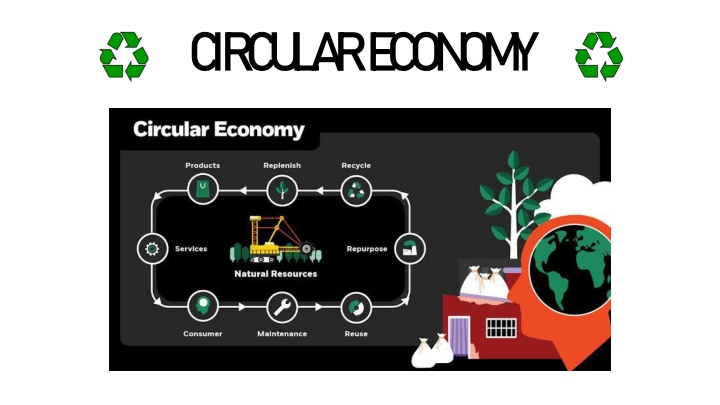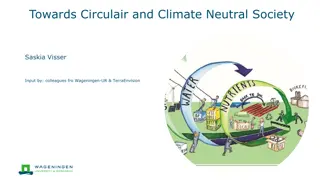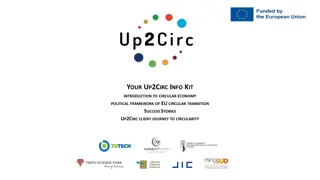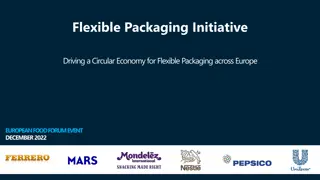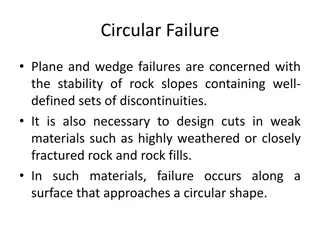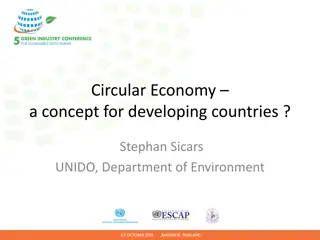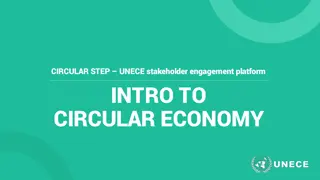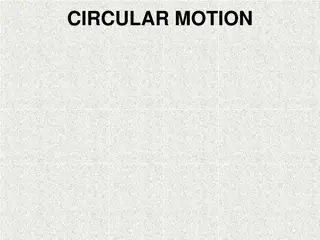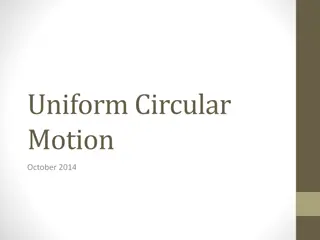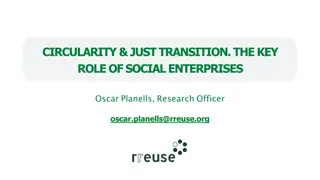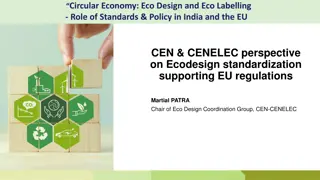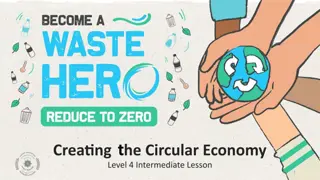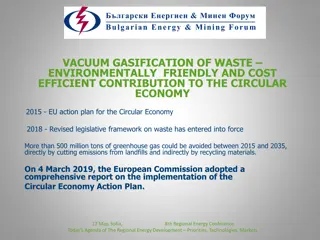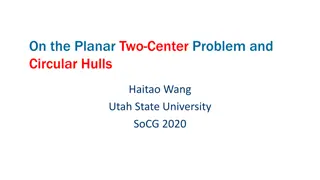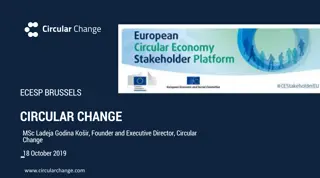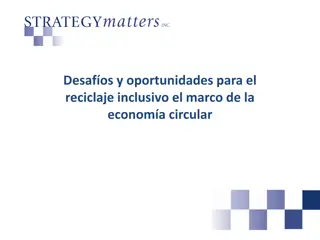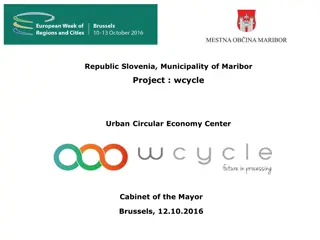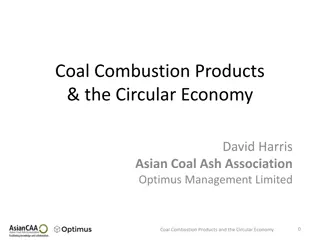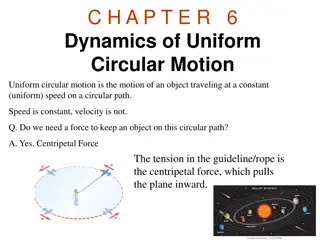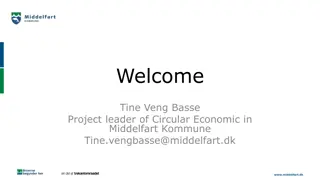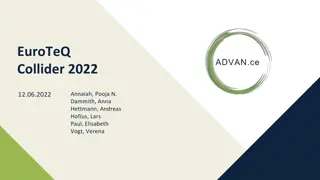Circular Economy Concepts and Models
Circular economy refers to transforming and recycling industrial economics, focusing on reuse of materials to reduce waste. Manufacturers design products for reusability, supporting sustainability. By transitioning towards a circular economy model, we aim to address environmental challenges and ensure healthy living conditions for future generations.
Download Presentation

Please find below an Image/Link to download the presentation.
The content on the website is provided AS IS for your information and personal use only. It may not be sold, licensed, or shared on other websites without obtaining consent from the author.If you encounter any issues during the download, it is possible that the publisher has removed the file from their server.
You are allowed to download the files provided on this website for personal or commercial use, subject to the condition that they are used lawfully. All files are the property of their respective owners.
The content on the website is provided AS IS for your information and personal use only. It may not be sold, licensed, or shared on other websites without obtaining consent from the author.
E N D
Presentation Transcript
W hatis circulareconom y? C ircular econom y is an industrial term , that refers to the transform ation and recycling of industrial econom ics rather than the process of production, use and destruction. In a circular econom y, m anufacturers design reusable products, because the aim is to reuse the m aterial. R educe (m inim um use of raw m aterials) R euse(m axim um reuse of products and com ponents) R ecycle(high quality reuse of raw m aterials)
W hy is circular econom y im portant? The w orld population is grow ing steadily, and this naturally directly affects the environm ent, so by 2050 w e have to sw itch from a linear econom y to a cyclical econom y to provide enough food, w ater and requirem ents to the w orld's population. Our goal is to ensure healthy, safe living conditions and less environm ental is to harm .
H ow do w e apply circular econom y? C ircular econom y is an econom ic m odel against the system , w hich is based on a disposable system , and the products based on ready-m ade production are shelved to be used again after using them at once. Therefore, the w astes that w ill be used in the circular econom y, the w orks that can be done in this field, the necessary budget, the people w ho can w ork in this field and the environm ents w here the w ork done should be determ ined w ell.
C ircular econom y business m odels: C yclical Supply C hain: C om panies that supply fully renew able, recyclable or biodegradable m aterials are not affected by rising prim ary raw m aterial prices, gaining com petitive advantage. R ecycling and R ecycling: P roduction and consum ption system s are created in w hich every m aterial previously considered to be w aste is brought back to life for different uses. E xtending P roduct L ife: W ith repairs, enhancem ents, rem anufacturing or rem arketing; econom ic benefits are provided for as long as possible from broken, spoiled, outdated products. Sharing Platform : A ll idle, unused large or sm all item s are rented and exchanged w ith sharing platform m odels; new relationships and business opportunities are em erging. P roduct as a Service: C onsum ers pay for products based on usage; that is, it is hiring and a radical change in the business m odel is provided.
W aste and recyling: P aper P aper recycling uses m echanical processes to chew up paper into individual fibers, creating a pulp that can be m ade into new paper. P roducts m ade from recycled paper can com e com pletely from recycled sources or contain a m ixture of new and recycled paper. U nlike m any other products, paper cannot be recycled indefinitely. The recycling process breaks the fibers, eventually m aking a product suitable only for low er-quality papers, such as new sprint. M etal N inety-nine percent of beer cans and 97 percent of soda cans in the U nited States are m ade fromalum inum .H ow ever, m ore steel -used prim arily for food storage containers, construction m aterials and autom obile parts - ends up in the w aste stream . A lum inum and steel are both sorted during the recycling process and m elted dow n to produce new item s, such as new beverage cans or autom obile parts. R ecycling m etals saves the cost and environm ental im pact of m ining virgin m aterials.
G lass R ecycling facilities crush glass and m elt it dow n for use in new glass products. Since recycled glass m elts at low er tem peratures than new glass, it takes less energy and creates less pollution to m ake a product out of recycled glass. M ost glass goes tow ard m aking beverage containers, but recycled glass has other applications, such as safety reflectors for roads.A lthough m any curbside program s accept glass, in 2009 A m ericans only recycled about 31 percent of glass containers . Plastics Plastics m ake up m ore than just w ater bottles; they also form durable goods like appliances and m edical devices, and nondurable goods like bags and diapers. U .S . use of plastics has risen in recent decades, and recycling plastics helps offsets the negative im pacts of high use. R ecycled plastics are ground into flakes that go into m aking new plastic products. You can identify the type of plastic and its recyclability by checking the num eric code that appears w ithin a triangle on the container. M unicipalities don't alw ays recycle all types of plastic, so check w ith your local sanitation departm ent before tossing all plastics into the recycling bin.
H azardous w astes H azardous w astes contain corrosive, toxic, ignitable or reactive ingredients and can threaten the safety of people and the environm ent if im properly handled. C om m on household hazardous w astes include m otor oil, pesticides, batteries and paints. Organic W astes Organic w astes --including yard trim m ings, paper and food scraps --m ade up over half of the solid w aste stream in 2009.D epending on its original form , organic w aste can be recycled into m ulches and com posts for gardening uses, or even be reborn as biodegradable products, paperboard, w ood packaging, fiberboard and particle board.
The huge am ount of w aste produced by the linear m odel is globally over 11 billion tons annually. Only 25% of this w aste is recycled and returned to the reproduction system . If w e do not m ake any significant changes in the current grow th m odel, it is expected that an increase of m ore than 75% of urban w aste and 35% of industrial w aste betw een 2013 and 2025. W hile the E conom ic C ooperation and D evelopm ent Organization (OE C D ) countries produce 4.6 billion tons of w aste each year, this figure is 2.2 billion in A sia P acific countries. 700 m illion industrial w aste, 300 m illion urban w aste, of the annual loss of w aste, reaching a total of 1 trillion. Is R ecycling E nough to Solve This P roblem ? N o. It only lightens the load. Instead of recycling, it is m ore econom ically plausible to prevent w aste from occurring prim arily by renew ing and reusing products and com ponents.
W e are currently consum ing 50% m ore resources than the am ount of pollution that the earth can reproduce and absorb. This excessive resource consum ption m easurem ent is called "ecological footprint". The total area occupied by people to produce the resources they consum e is defined as the places they use to build their buildings and roads and ecosystem s that elim inate the effects of the w aste they cause. These data are com pared w ith the data of the biologically productive areas called biocapacity R esponsibility of the C om panies P eople now hold com panies as w ell as governm ents responsible for im proving their quality of life. A ccording to a study by the U N G lobal Im pact and A ccenture, w hich has 30,000 people on five continents, 72% of respondents believe their use is insufficient to m eet expectations for social benefit.
To support the adoption of circular econom y principles, the E llen M cA rthur Foundation, a non-profit organization funded by a leading group of global com panies, w as established. The foundation focused m ainly on gathering different schools of thought around an integrated fram ew ork called "circular econom y".
